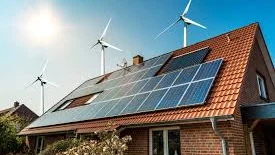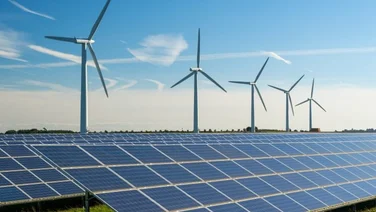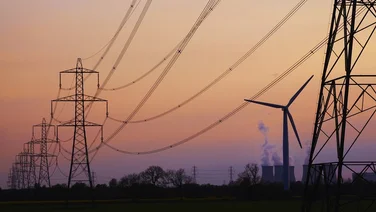✔ Pumped storage is a reliable energy system with a 90% efficiency rate
✔ It works by using excess electricity to pump water from a lower reservoir to a higher one, storing energy
✔ The infrastructure can be expensive to build but can last for decades with proper maintenance
Pumped storage is an intriguing hydropower technology that’s been quietly working its magic since the early 20th century.
Today, the largest pumped storage power station in the world generates around 3,600 MW (megawatts) of renewable energy – or just over 3.4 terawatt-hours (TWh) per year. That’s enough to power the whole of Botswana each year.
In this article, we’ll take a closer look at the pros and cons of pumped storage, uncovering how it keeps our lights on when we need them most and why it’s not without its challenges.

What is pumped storage?
Pumped storage is a type of large-scale, hydroelectric power generation system that stores excess energy during lower demand times and then releases that energy to generate electricity when it’s needed.
How does pumped storage work?
Pumped storage works by using two water reservoirs at different elevations. When there’s excess electricity, that surplus power is used to pump water from the lower reservoir to the upper one.
When electricity demand peaks, it immediately releases the stored water downhill, passing through turbines to generate electricity. It’s essentially a giant energy storage system that helps balance supply and demand for the electrical grid.
What are the pros and cons of pumped storage?
- An efficient way to store excess electricity for later use
- Helps balance supply and demand
- Can quickly generate power when demand spikes
- Infrastructure can last for decades with proper maintenance
- Generates renewable electricity without direct greenhouse gas emissions
- Building reservoirs and infrastructure can be expensive
- It needs the right geography to work properly
- Not 100% efficient, as it loses some energy during the pumping process and over time
- Regulatory hurdles and environmental concerns can slow development

The 5 pros of pumped storage
1. It’s an efficient way to store excess electricity
Pumped storage is a smart way to save electricity for later when it’s needed most. According to a 2021 research study, the energy cycle between the two reservoirs has a whopping 90% efficiency level – meaning that it only loses 10% of the surplus energy that passes through its turbine.
Compared to other forms of energy storage, like storage batteries, which only have a 50-80% efficiency level, pumped storage is much more reliable and cost-effective.
2. It helps balance supply and demand
When it comes to maintaining the balance between electricity supply and demand, pumped storage is a star player. Because of its efficiency in hoarding excess energy, it’s like having a secret energy stash to use whenever there’s a blackout looming.
Thanks to pumped storage, we can keep the lights on and avoid those frustrating moments of darkness – it acts as a rapid-response backup, preventing grid overloads.
3. It can quickly generate power when demand spikes
When electricity demand suddenly skyrockets, pumped storage springs into action with a lightning-fast response time. It can quickly generate power to meet the increased demand and prevent any strain on the electrical grid.
Whenever you’re enjoying a hot shower or binge-watching your favourite show during a peak demand period, you can thank pumped storage for keeping the power flowing smoothly.
4. With proper maintenance, the infrastructure can last for decades
With a little TLC, pumped storage infrastructure can be a durable workhorse for decades to come. Regular maintenance is key to keeping the turbines, pumps, and reservoirs in good shape. Just like those ol’ faithful cars that keep ticking along with regular tune-ups.
This longevity makes them a solid investment for providing consistent energy storage and grid support over the years, without constantly needing replacements or upgrades.
5. It generates 100% clean electricity
The beauty of pumped storage is that it generates electricity by using the power of clean and renewable hydropower, without emitting greenhouse gases.
Plus, it recycles water, preventing waste and conserving precious resources. It’s a win-win for the planet: reducing emissions to help fight climate change and being smart about our water use, all while keeping the lights on.
The 4 cons of pumped storage
1. Building reservoirs and infrastructure can be expensive
Constructing the reservoirs and infrastructure for pumped storage can come with a hefty price tag. The need for two carefully located reservoirs, pumps, and turbines, plus the intricate engineering work involved, all adds up to substantial upfront costs. And let’s not forget about the maintenance costs down the line.
However, many see this investment as worthwhile because of the long-term benefits of grid stability and reliable energy storage that pumped storage provides.
2. It needs the right geography to work properly
Given that gravity plays quite a significant role in pumped storage, it’s not possible to set up shop just anywhere – a pumped storage system needs the right setting, like hilly terrain or mountains and valleys, to work effectively.
Without that elevation difference between the upper and lower reservoirs, the whole energy storage concept goes downhill – and not in a useful way. Obviously, this limits where these systems can be built.
3. It’s not 100% efficient
Pumped storage, though highly efficient, isn’t flawless. As mentioned earlier, a small amount of energy (around 10%) sneaks away during the water-pumping stage, a bit like a slow tyre puncture.
Also, over time, sediment can get swept into the reservoirs, reducing their capacity. Again, it’s like a bucket slowly filling up with sand – not ideal, but with proper maintenance, these hiccups can be managed.
4. Plans for new pumped storage facilities can be blocked by regulatory hurdles and environmental concerns
Pumped storage projects sometimes hit a roadblock in the form of regulatory red tape, as balancing the need for clean energy with environmental preservation can be tricky.
Environmental concerns can put the brakes on development, with local communities and environmental groups voicing their apprehension over potential disruptions to local ecosystems – especially local habitats and waterways.
These valid concerns can slow down development, as navigating complex permitting processes and addressing environmental impact studies becomes necessary.
Summary
As we wrap up our exploration, we can see that pumped storage has a useful part to play in our quest for grid stability and renewable energy integration. Its efficient energy storage and rapid response to demand spikes are undeniable assets.
However, it’s not without its challenges – the need for the right landscape, environmental concerns, and the upfront price tag all need to be considered. With that being said, it’s all about finding the balance for progress towards our collective net-zero goals.
Pumped storage: FAQs
What is meant by pumped storage?
Pumped storage is a grid-balancing energy storage system which uses surplus electricity to pump water between two reservoirs at different elevations. It stores excess energy during lower demand times and then releases that energy to generate electricity when it’s needed.
How does a pumped storage scheme work?
A pumped storage scheme works by using excess hydroelectricity to pump water from a lower reservoir to an upper one, storing energy. During peak demand, the system reacts by releasing its stored water downhill, passing through turbines to generate electricity.
What is the difference between pumped storage and dams?
Dams and pumped storage have different functions. Pumped storage is a type of energy storage system that uses two reservoirs at different elevations to store and generate electricity. But the main purpose of dams is to control water flow. They store water for different purposes, like irrigation and drinking water, but can also be used for hydroelectric power generation.






